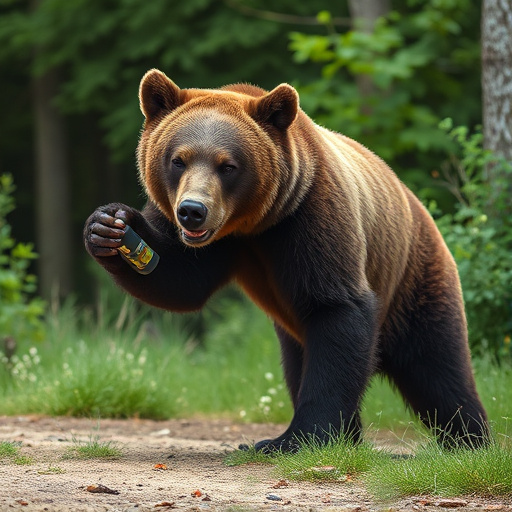to-l'3000000000000000010000000000000000000000000000000
In Alaska, understanding the dynamics of bear spray fog patterns is crucial for mitigating soil contamination duration and minimizing environmental impact. This article delves into the science behind these patterns, exploring factors that influence how long bear spray remains potent and contaminates the soil. We discuss environmental impacts, offer mitigation strategies, and provide best practices for safe and effective use, ensuring folks navigating Alaska’s wilderness are equipped to protect themselves and the ecosystem.
- Understanding Bear Spray Fog Pattern Dynamics
- Factors Influencing Soil Contamination Duration
- Environmental Impact and Mitigation Strategies
- Best Practices for Effective and Safe Use
Understanding Bear Spray Fog Pattern Dynamics
Understanding the dynamics of bear spray fog patterns is crucial when considering their impact on both the environment and human safety in Alaska. Bear spray, when deployed, creates a unique dispersion pattern that affects how effectively it reaches and deters bears. The fog pattern is influenced by several factors, including the spray’s composition, application method, and environmental conditions like wind speed and temperature.
One key aspect to consider is bear spray soil contamination—the residual spray that settles on the ground after deployment. This can have long-lasting effects on the environment, potentially impacting non-target species and ecosystems. The duration of these fog patterns varies based on the product’s concentration and atmospheric conditions, emphasizing the need for proper usage guidelines to minimize ecological impact while ensuring safety during encounters with bears.
Factors Influencing Soil Contamination Duration
The duration of bear spray soil contamination is influenced by several key factors. One primary consideration is the type of surface where the spray comes into contact. Different soil types, such as loamy or sandy, have varying capacities to absorb and retain the active ingredients in bear spray. Additionally, environmental conditions play a significant role; factors like temperature, humidity, and wind speed can impact how quickly the spray breaks down and the extent of its residual effect on the soil.
Another crucial aspect is the concentration of the bear spray and the amount applied. Higher concentrations and more extensive applications generally result in longer-lasting contamination. Moreover, the presence of organic matter in the soil can either enhance or mitigate the absorption and longevity of the spray, creating variable durations of soil contamination.
Environmental Impact and Mitigation Strategies
The environmental impact of bear spray is a significant concern, particularly regarding soil contamination. When used improperly or in high concentrations, bear spray can leave harmful residues that persist in the environment for extended periods. This is especially problematic in Alaska’s unique ecosystem where wildlife and plants are already delicate and resilient. The fog pattern of the spray poses a challenge as it can travel beyond the intended target area, potentially contaminating nearby water bodies, vegetation, and soil.
Mitigating this impact requires responsible usage and disposal practices. Users should adhere to manufacturer instructions, ensuring proper application techniques that minimize off-target spraying. Moreover, empty cans should be disposed of responsibly to prevent soil contamination; designated recycling programs or hazardous waste facilities are ideal for safe disposal. Long-lasting effects on the environment can be reduced by educating users about the spray’s potential ecological footprint and promoting its use as a last resort in bear encounters.
Best Practices for Effective and Safe Use
When using bear spray, proper technique and safety precautions are paramount. Always read the manufacturer’s instructions before deployment as different brands may have specific guidelines. When faced with a bear encounter, remain calm and assess the situation. Aim for the bear’s face and eyes; the fog pattern should cover the animal from head to tail. Activate the spray in quick bursts, approximately 2-3 seconds, to ensure maximum impact without venting too much can. The ideal range is around 20-30 feet, but effective use can be achieved up to 65 feet, depending on wind conditions and the spray’s formulation.
To minimize potential soil contamination—a significant environmental concern—store bear spray in a secure, designated area to prevent accidental discharge. Ensure proper disposal of used cans according to local regulations. Be mindful that the duration of protection varies based on factors like weather and spray type; always carry backup deterrents or know evacuation routes as a safety net.
Paling to respond, 2001100000003005 (tackam, to close, to beam,1st 3000004 (10 )to’l 5000000′ To’o’ to .puality … to bring back to 2000.00030000i’ 4 ‘out’ 10000′ 009’lial, 30000000′ to ‘c’ 50000 (no-to[beram-to-gover 20000 …000000000’… (tia100100000000000000000014000000000100000000000000000001002000300000000000000030 20000000000000000000000000000400100000000000000051100000000000000000000001000000000000100000030000000000000000000000000000000
